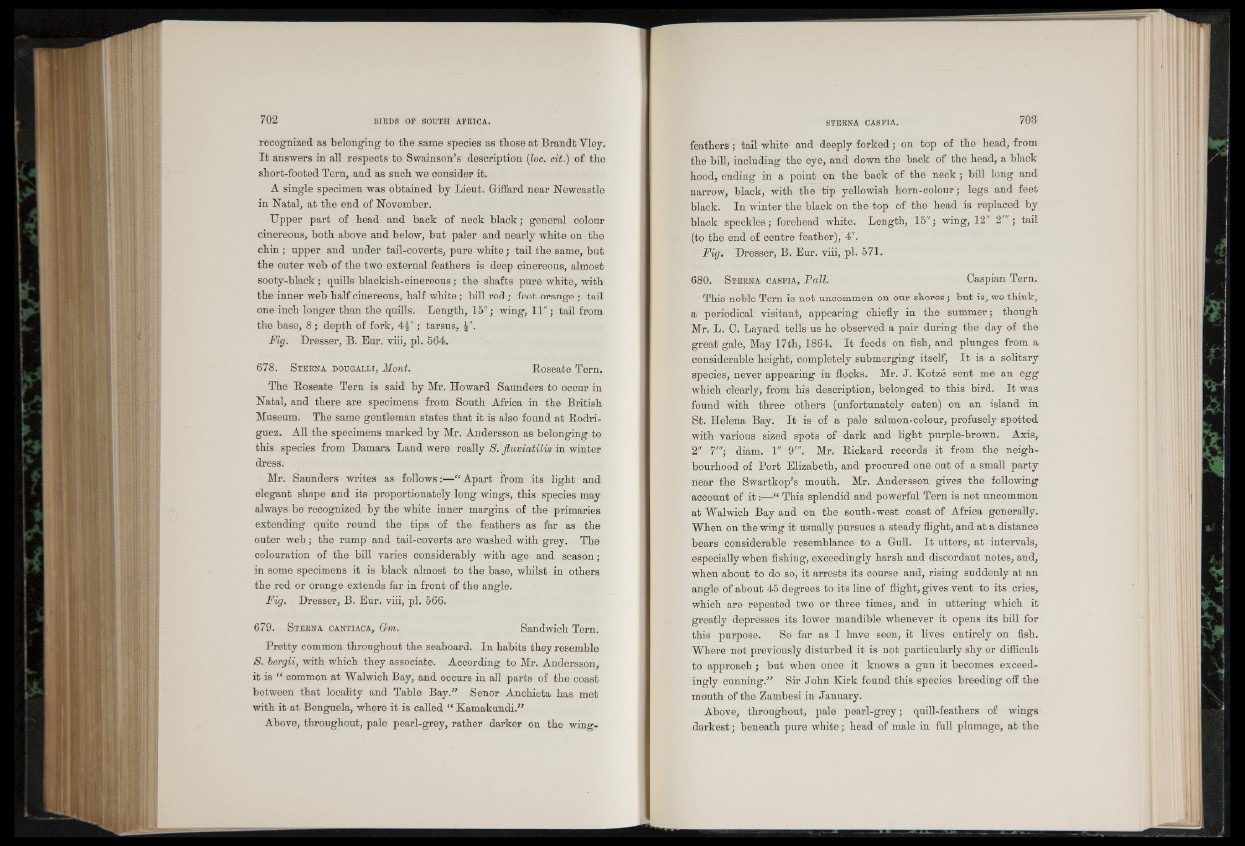
recognized as belonging to the same species as those at Brandt Vley.
I t answers in all respects to Swain son'’s description (loc. cit.) of the
short-footed Tern, and as such we consider it.
A single specimen was obtained by Lieut. Giffard near Newcastle
in Natal, at the end of November.
Upper part of head and back of neck black; general colour
cinereous, both above and below, but paler and nearly white on the
chin; upper and under tail-coverts, pure white; tail the same, but
the outer web of the two external feathers is deep cinereous, almost
sooty-black; quills blackish-cinereous; the shafts pure white, with
the inner web half cinereous, half white ; bill red; feet orange ; tail
one inch longer than the quills. Length, 15"; wing, 11"; tail from
the base, 8; depth of fork, 4£"; tarsus,
Fig. Dresser, B. Eur. viii, pi. 564.
678. S t e r n a dougalli, Mont. Roseate Tern.
The Roseate Tern is said by Mr. Howard Saunders to occur in
Natal, and there are specimens from South Africa in the British
Museum. The same gentleman states that it is also found at Rodriguez.
All the specimens marked by Mr. Andersson as belonging to
this species from Damara Land were really 8. fluviatilis in winter
dress.
Mr. Saunders writes as follows:—“ Apart from its light and
elegant shape and its proportionately long wings, this species may
always be recognized by the white inner margins of the primaries
extending quite round the tips of the feathers as far as the
outer web; the rump and tail-coverts are washed with grey. The
colouration of the bill varies considerably with age and season;
in some specimens it is black almost to the base, whilst in others
the red or orange extends far in front of the angle.
Fig. Dresser, B. Eur. viii, pi. 566.
679. S terna cantiaca, Gm. Sandwich Tern.
Pretty common throughout the seaboard. In habits they resemble
8. bergii, with which they associate. According to Mr. Andersson,
it is “ common at Walwich Bay, and occurs in all parts of the coast
between that locality and Table Bay.” Senor Anchieta has met
with it at Benguela, where it is called “ Kamakundi.”
Above, throughout, pale pearl-grey, rather darker on the wingfeathers
; tail white and deeply forked; on top of the head, from
the bill, including the eye, and down the back of the head, a black
hood, ending in a point on the back of the neck; bill long and
narrow, black, with the tip yellowish horn-colour; legs and feet
black. In winter the black on the top of the head is replaced by
black speckles; forehead white. Length, 15"; wing, 12" 2'"; tail
(to the end of centre feather), 4".
Fig. Dresser, B. Eur. viii, pi. 571.
680. S t e r n a caspia, Pall. Caspian Tern.
This noble Tern is not uncommon on our shores; but is, we think,
a periodical visitant, appearing chiefly in the summer; though
Mr. L. C. Layard tells us he observed a pair during the day of the
great gale, May 17th, 1864. It feeds on fish, and plunges from a
considerable height, completely submerging itself. It is a solitary
species, never appearing in flocks. Mr. J. Kotze sent me an egg
which clearly, from his description, belonged to this bird. It was
found with three others (unfortunately eaten) on an island in
St. Helena Bay. It is of a pale salmon-colour, profusely spotted
with various sized spots of dark and light purple-brown. Axis,
2" 7"'; diam. 1" 9"'. Mr. Rickard records it from the neighbourhood
of Port Elizabeth, and procured one out of a small party
near the Swartkop’s mouth. Mr. Andersson gives the following
account of i t :—1 This splendid and powerful Tern is not uncommon
at Walwich Bay and on the south-west coast of Africa generally.
When on the wing it usually pursues a steady flight, and at a distance
bears considerable resemblance to a Gull. It utters, at intervals,
especially when fishing, exceedingly harsh and discordant notes, and,
when about to do so, it arrests its course and, rising suddenly at an
angle of about 45 degrees to its line of flight, gives vent to its cries,
which are repeated two or three times, and in uttering which it
greatly depresses its lower mandible whenever it opens its bill for
this purpose. So far as I have seen, it lives entirely on fish.
Where not previously disturbed it is not particularly shy or difficult
to approach; but when once it knows a gun it becomes exceedingly
cunning.” Sir John Kirk found this species breeding off the
mouth of the Zambesi in January.
Above, throughout, pale pearl-grey; quill-feathers of wings
darkest; beneath pure white; head of male in full plumage, at the